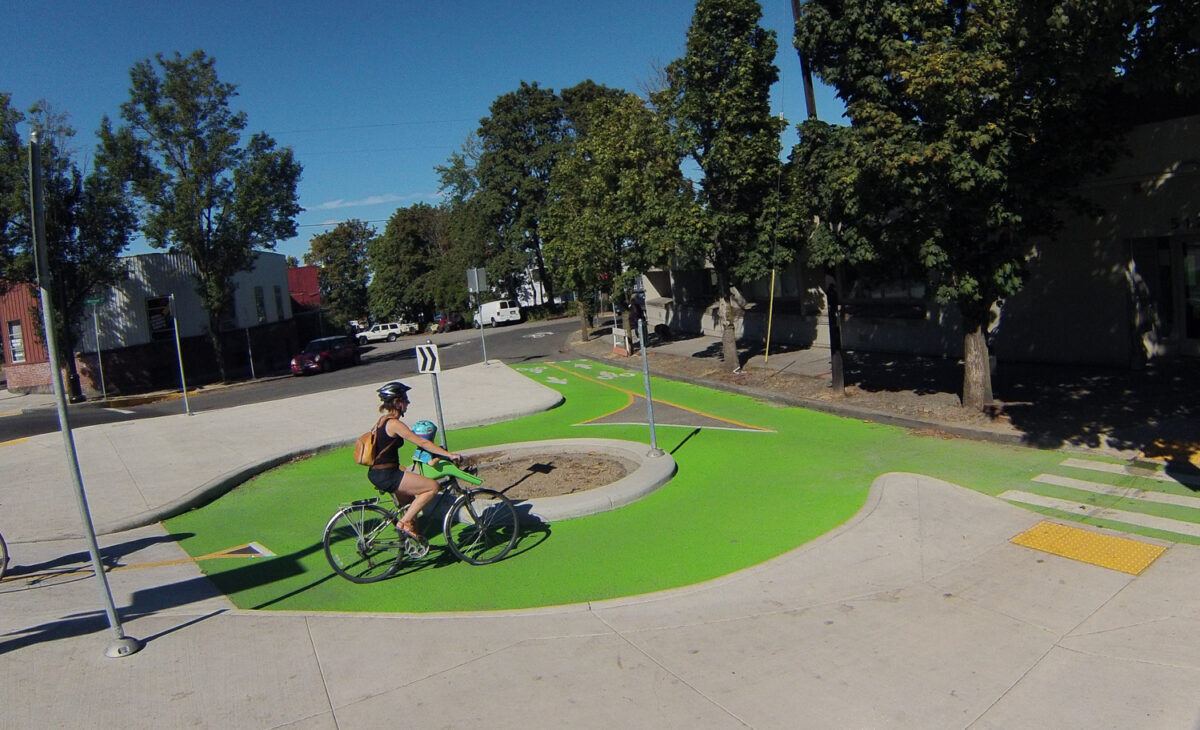
(Photos: Jonathan Maus)
Portland traffic engineers and planners have a new favorite treatment when two bike routes intersect: a traffic circle!
As part of the SE 19th Neighborhood Greenway project in Sellwood, the Bureau of Transportation has installed a large median and roundabout at the intersection of SE Milwaukie and Mitchell. In what used to be a wide-open intersection across from Oaks Bottom Wildlife Refuge trailhead is now a traffic-calming island and green pathways that connect to a new flashing beacon and crosswalk.
It’s been almost two years since we covered the city’s first bicycle roundabout on NE 21st. After that debuted, PBOT proposed another one on the northern landing of the forthcoming Sullivan’s Crossing bridge in the Lloyd. That one didn’t make the final design cut, but that didn’t stop them from proposing another one on NE Ainsworth as part of the Lloyd to Woodlawn Greenway project.
Advertisement
The one at Milwaukie and Mitchell is much more robust than any of the designs built or proposed so far. The median is very big relative to traditional designs. It could be a nice plaza if they put a few benches on it and maybe a piece of public art or two. From a user perspective, it’s pretty self-explanatory. That’s in part because PBOT spared no expense with their use of bright green thermoplastic on the pavement and wayfinding signage on each end.
If you want to go from Milwaukie northbound to Mitchell in order to cross McLoughlin at 17th — or vice versa — you just continue through on the curbside. If you want to head west toward the Springwater via Oaks Bottom (or onto southbound Milwaukie, which isn’t a nice place to ride), the circle drops you right at a nice new crossing. Just push the button (not sure why all these aren’t outfitted with automatic loop sensors) and the lights flash. With a more narrow cross-section on Milwaukie and the addition of caution signs and crosswalk markings, people seem much more willing to stop and wait for crossers.
While I was out there last weekend I saw all types of riders using the circle. It’s definitely not a standard design so it might take some getting used to. Overall it feels like a nice improvement compared to the old intersection that provided zero protection for vulnerable users and did nothing to calm traffic.
It’s also pretty fun to zoom around it a few extra times if you’re in the mood…
Have you ridden this yet? What do you think?
— Jonathan Maus: (503) 706-8804, @jonathan_maus on Twitter and jonathan@bikeportland.org
Never miss a story. Sign-up for the daily BP Headlines email.
BikePortland needs your support.



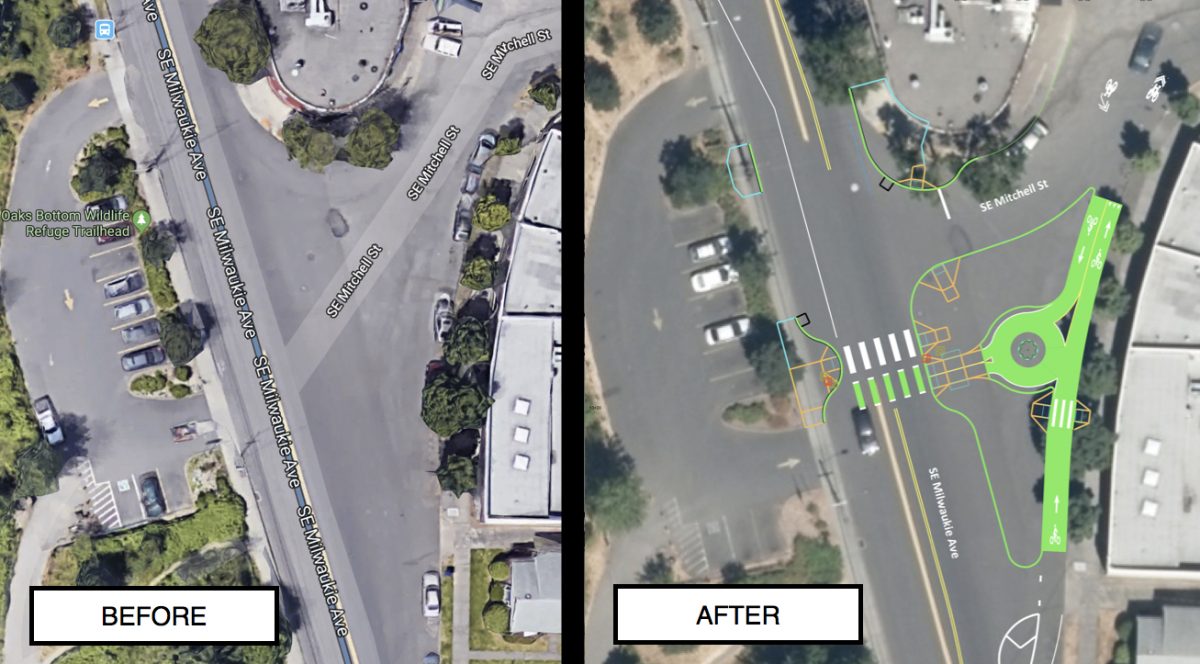
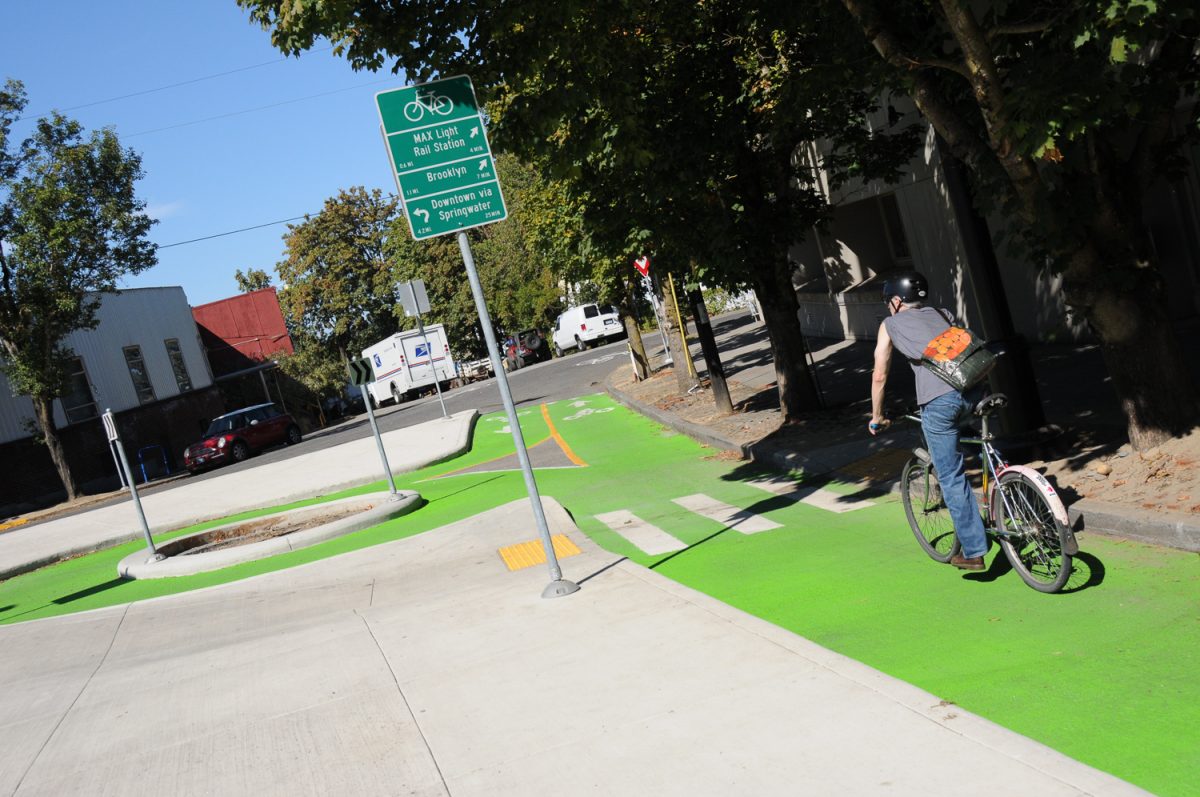
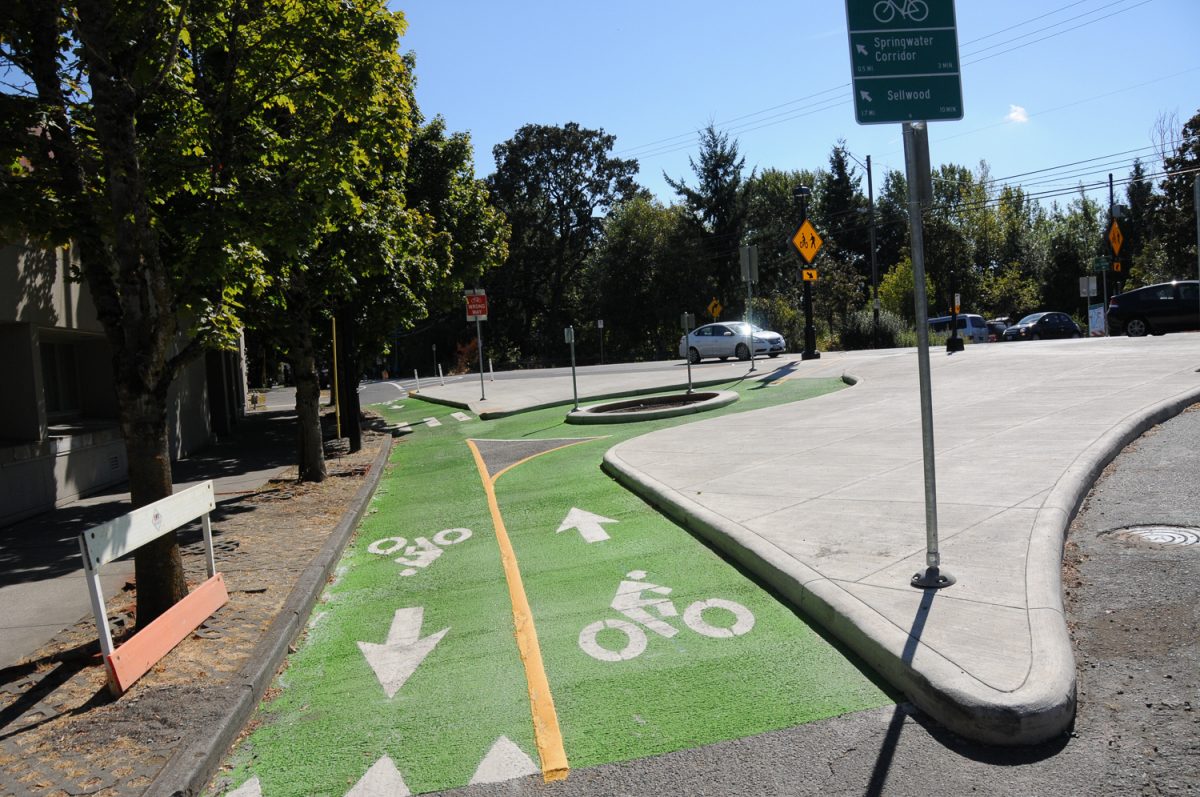
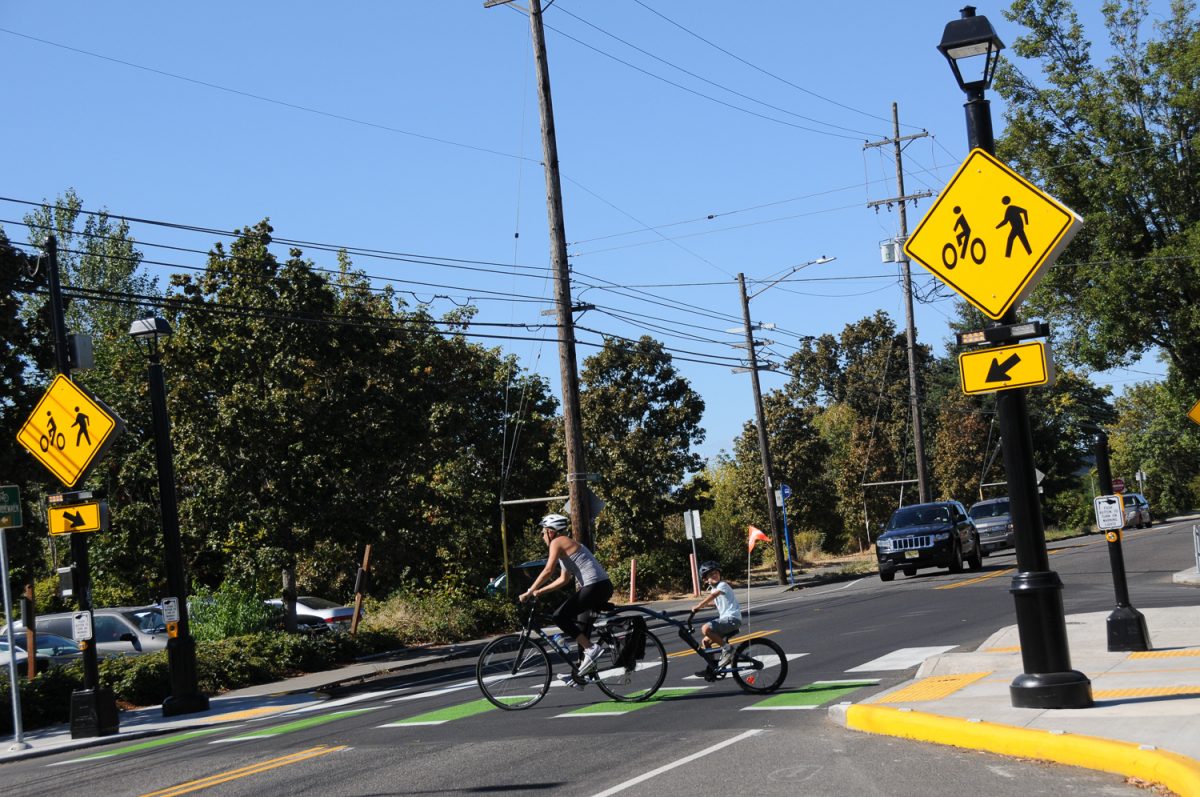
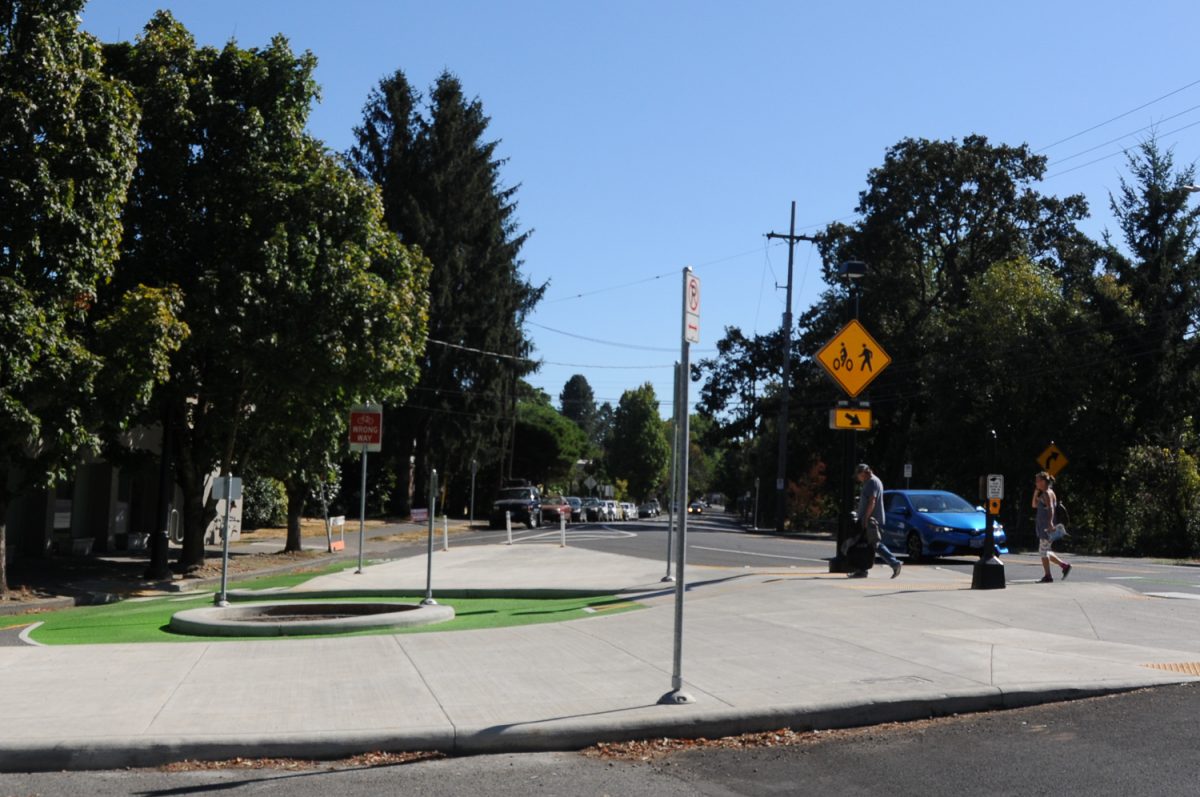
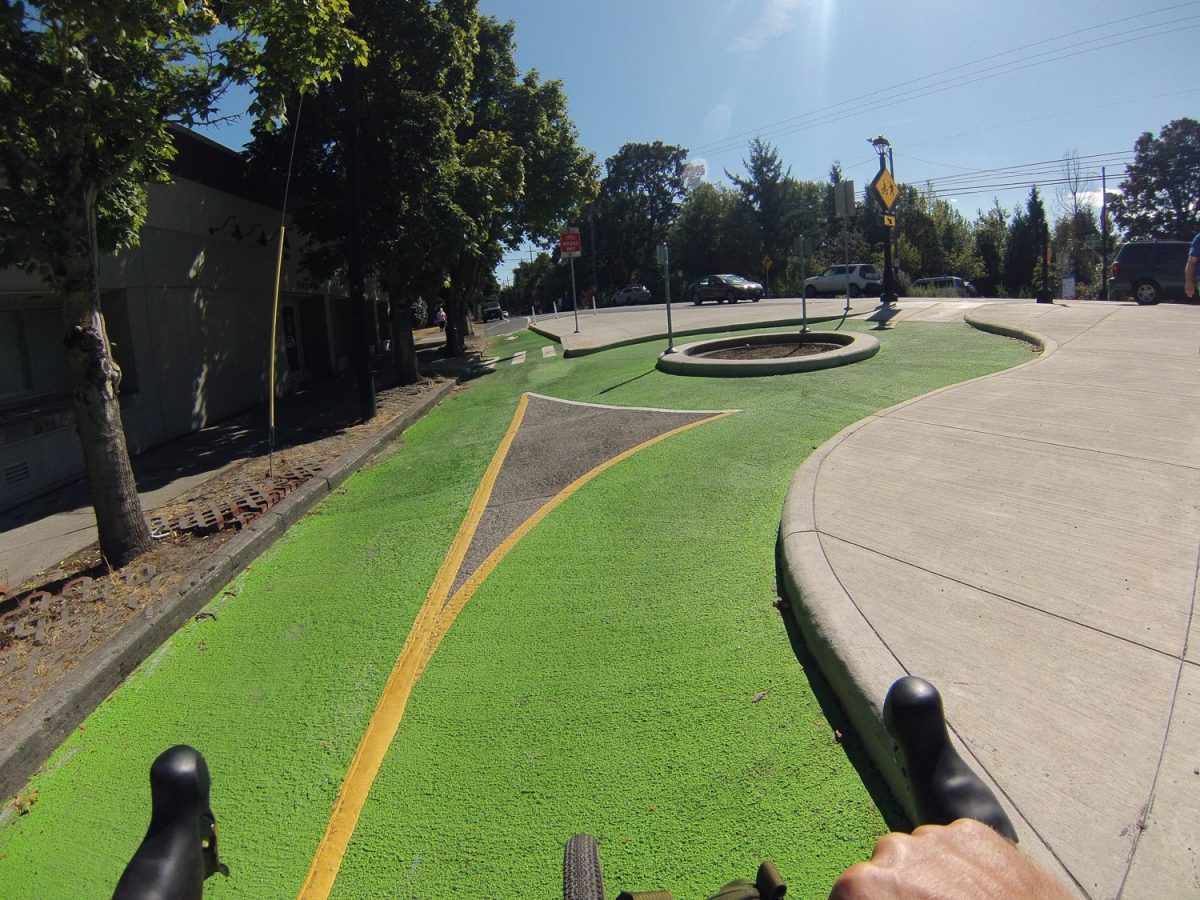
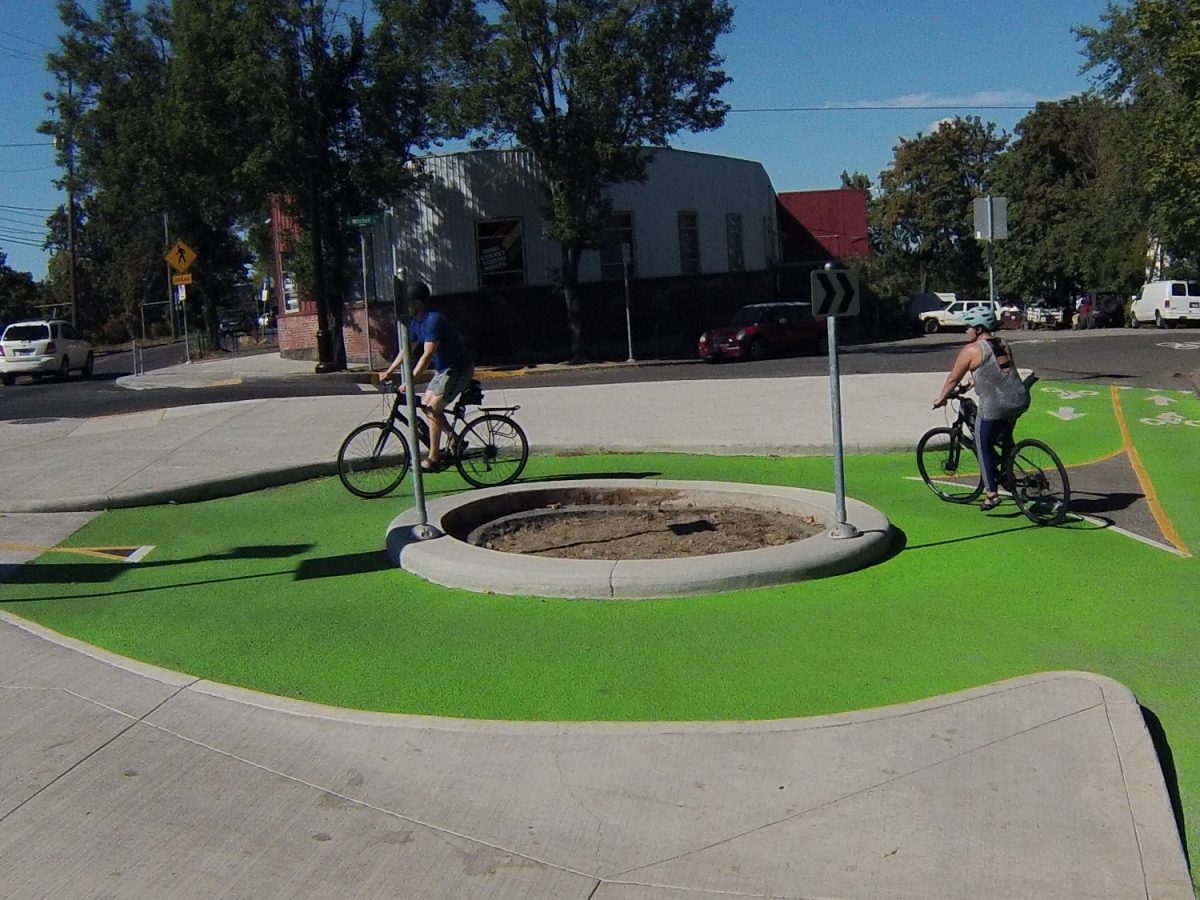

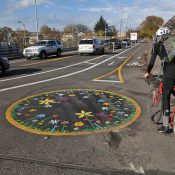
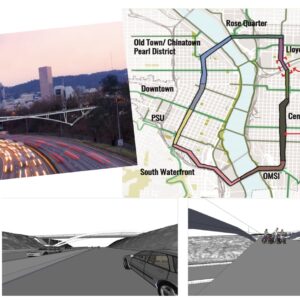
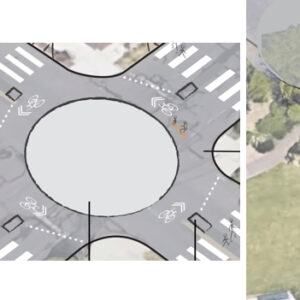
Thanks for reading.
BikePortland has served this community with independent community journalism since 2005. We rely on subscriptions from readers like you to survive. Your financial support is vital in keeping this valuable resource alive and well.
Please subscribe today to strengthen and expand our work.
This is so stupid. Bikes are not cars, so why treat them as such? Cyclists can easily handle navigating around each other – all this roundabout does is limit the amount of space given to cyclists and creates a very tight turn for no good reason other than “it looks cool”. What a waste of our very limited resources for cycling infrastructure. Spend the money on concrete to protect cyclists from motor vehicles, not other cyclists.
https://bicycledutch.wordpress.com/2015/03/10/a-bicycle-roundabout-that-shouldnt-have-been-built/
The article you linked to placed a roundabout in an area with no possible turns. That one was unnecessary, but a completely different context than is shown here. This one seems to allow people to turn left much more easily than using one of those left-turn waiting boxes, or some other method. It seems like this will help the flow of bike traffic, and also does protect people biking from motor vehicles, as your post mentions.
[Mistakenly didn’t hit “reply” button]
True, but my intent was to point out the article’s point about treating bikes like mini-cars and adding sharp curbs needlessly. All this design does is create a barrier for cyclists for no reason. The protection from motor traffic is appreciated, but this should have been a Y-intersection instead of a roundabout. The curb in the middle presents a safety hazard, adding a sharp curb and a tight turn with zero visibility striping – especially a problem at night given Portland’s terribly-lit streets.
A Y-intersection with rounded corners would do just fine here.
But it’s unneccessarily, stupidly, narrow; as if the purpose is to slow bicycles down so they don’t kill..what, other cyclists? That’s the whole point of his post.
Rage. Who’s in charge of this stuff? … Stop making infrastructure to slow cyclists down, this is like the irritating 90 degree turns that are showing up everywhere.
Also the graphic for the “After” picture needs to be updated to show the egregiously narrow entry angle.
It’s the exact same traffic pattern. It would have been easier, cheaper and less confusing to all involved to build a wide curve, bring the one-way approach in at the elbow and give it a yield sign.
More dangerous curbed hardscape to hit and crash your bike on, this is so stupid.
And sheet water off of! As far as storm water absorption goes it’s about 98% dreck. Instead of having a low-angle border of rideable pavers fronting the bike circle and paths: More Hard Stuff. Portland bike riders will be right at home in that little rill which is the true marker of our bike infrastructure.
I’m not sure I’ll even be able to make it around this on my bacchetta, its hard even turning around on a normal neighborhood street.
I don’t think it’s “stupid.” Good job PBOT!
The article you linked to placed a roundabout in an area with no possible turns. That one was unnecessary, but a completely different context than is shown here. This one seems to allow people to turn left much more easily than using one of those left-turn waiting boxes, or some other method. It seems like this will help the flow of bike traffic, and also does protect people biking from motor vehicles, as your post mentions.
I mean, I guess if we can’t have Idaho Stop, parked spaces removed from corners, or speed laws enforced, we may as well have silly circles.
Who’s up for the SE19th 500??
It’s too small to be useful, it seems to me.
Davis, CA pioneered bicycle roundabouts in the 1970s, they did well with large ones, then built a small one like this in 2002.
Now they’re back to building large diameter ones.
This one is so small (as is the one on the 21st Ave overpass) that you can’t ride through it at any sort of standard bicycling speed. You need to slow to walking speed to make that curve. Which adds a bunch of complicating features, like, it’s difficult to ride a bike at a walking speed, and you need more space to wobble.
At least on 21st Ave you can ride right through the middle (as I always do southbound, despite having a habit of following traffic markings). With this those curbs provide an additional hazard.
Roundabouts are really useful where you have a lot of traffic in 3 or 4 different directions, and road users can’t filter themselves through naturally. With this low-traffic situation, it seems a big open intersection area, or a “wye” shaped intersection would be safer and more functional.
I’ll withhold full judgement until I’ve actually ridden it.
Ted Buehler
I’ve noticed this sort of thing happening in various bicycle infrastructure projects and not just in Portland. There is a perceived need to change the way people ride in mixing zones or crossings or whatever.
But solution they come up with is to slow bicycle traffic by making the infrastructure dangerously difficult to navigate. If you come up on this thing for the first time in the dark and don’t know already know how it is configured, you risk getting pitched on head if you don’t divine the nature of the obstacles in your path.
And a novice rider isn’t going to be comfortable riding in that narrow space near the curbs at any speed. This seems like the opposite of what we’re supposed to be doing.
Absolutely. If we are to design “all ages facilities” that are comfortable for the 8-80 crowd, it must be safe to navigate at a reasonable speed during the night time for a person encountering it for the first time. Failure to do so is the antithesis of the 880 philosophy which is meant to appeal to the majority “interested but concerned!” The turning radius of these facilities should accommodate an average bicycle traveling speed. These tight circles fail to do that. If you want to see an example of a successful roundabout, look at the Netherlands or the waterfront of Reykjavik, Iceland. They’re wide enough to safely accommodate cyclists, pedestrians, and auto drivers at the same time with enough space to safeguard against miscalculations.
Not coincidentally, the people in charge when Davis when was doing full-size roundabouts weren’t the “one right way to ride a bike: 8 mph, upright and segregated” crowd. The result was a cycling modal share that would make a Dutchman jealous (while it lasted). In fact, the biggest hurdle was finding bike parking. (Most of the bike parking has since been removed, but there is no shortage these days.) When the separation crowd took over in the ’90’s, they proved that you can build it and they will go away.
That’s a bold hypothesis based on correlation with no evidence of causation. Using your logic, The Netherlands should have zero cyclists.
Do notice that I said Davis proves that you CAN build it and have the bikes go away, not that they necessarily will go away. Allow me to further clarify what I mean. In an American social infrastructure context, I believe it is foolish to assume that we can simply build cheap copies of European physical infrastructure and get similar outcomes. Note that in the Netherlands you have the following (partial list) of social infrastructure features that are completely missing on this side of the pond:
1. Driver education, training and testing
2. Relatively expensive licenses to drive that are relatively easily lost
3. Traffic law enforcement, including automated
4. Strict liability that places the blame on motorists for collisions
5. Relatively dense urban populations
6. Relatively complete and functional public transit
7. Relatively expensive driving as compared to alternatives
8. Inconvenient car storage as compared to the US
9. A relatively socially conscious population
Even with all of that, their bikes are primarily used as a substitute for walking, not driving. However, since they have built themselves into such trip distances being quite common, there is a noticeable amount of cycling.
I’ll just add that there is a move afoot to remove many separated implementations in several Northern European nations and do more sharrow-type things. This isn’t because of failure, it’s primarily because they built the cycling infra too narrow and are now confident of taking over the streetscape, with some allowance for finding that even with all their social infrastructure advantages some builds do fail (two-way sidepaths being the primary example).
All the listed social infrastructure points are no doubt important in protecting vulnerable road users, but those should not be overstated as the main drivers for mass cycling in the Netherlands. For one, many of them are not unique to just the Netherlands and the costs of certain ones can be even higher in some of the other Northern European countries. At the same time, the importance of separated bicycle infrastructure should not be underestimated in the transportation equation, as this is a major cornerstone of Dutch traffic engineering. It can never be the only piece of the equation, but it is absolutely essential. Maybe some of the other neighboring countries are experimenting with sharrow-like solutions, but the Netherlands does not implement such a treatment without simultaneously using other traffic calming measures, such as preventing through-traffic or speed-calming, etc. I don’t know what Davis has built over the years, but from what I’ve read it apparently has little dedicated or separated bicycle infrastructure. Maybe they didn’t build/implement things correctly or sufficiently. A few missing links here and some poor/no treatments there can make the fragmented network unattractive for most people.
And maybe I’m splitting hairs or misreading what you meant. But it’s not accurate to say that cycling only replaces walking trips. Indeed, the bicycle alone (for at least the majority of Dutch people) doesn’t tend to replace car journeys at distances above 5-7 miles, but the combination of bike with transit does for many longer trips, especially work commutes. And high schools are usually only located in larger towns and cities, so many kids from smaller towns/villages have to bike considerable distances, some up to 20 miles a day or more roundtrip. The infrastructure is there to facilitate this. Whether people will choose to bike long distances or not is another matter.
PBOT: solving its last remaining problems in the only way possible.
I live nearby to this and have ridden this section of Milwaukie to access the Springwater as part of my daily commute for over 10 years. While I agree the overall design has flaws, it’s a massive improvement over the previous scenario, and leads to a far safer crossing situation for most users. More comfortable riders (I forget the appropriate BP term) can still make a take-the-lane left turn when heading northbound easily enough and forego the roundabout, esp. if traffic is light. But at rush hours, it’s a much safer option.
As traffic has gotten heavier on the section of SE Milwaukie b/w SE Holgate and SE Bybee (there’s only one traffic control device on this section, @ Tolman), this adds a significantly more appealing option to cross for peds and bikes, and w/ the closure of the Springwater and re-routing of cyclists onto the 19th Ave greenway it’s a necessary update.
People on here can and will criticize its design, and they should. But as someone who literally uses it every day I’m glad for it. I do wish they’d add a tree to the center and /or some other aesthetically inclined elements.
Jonathan, did you inquire with PBOT engineers what this device’s purpose was, rather than infer by what it looks like? It’s cute and utterly useless as a traffic circle for all the reasons mentioned above, but it does function as a traffic calming device to slow bicyclists down just before crossing SE Milwaukie Ave or just after, to slow fast users down to pedestrian speeds.
So… would PBOT be willing to build a similar facility for cars? i.e. to use a traffic circle as a speed reduction device?
I for one am somewhat annoyed at PBOT building facilities that would never pass muster for auto users, but, for some reason, seem fine for cyclists (sharp, pointless jogs, swing gates, posts in the middle of the path, go-straight lanes to the right of right-turn lanes, signals that can’t be seen from the “stop line”, etc.)
They do it all the time. There are a lot of small traffic circles in the middle of intersections on greenways.
They don’t do it at all any more. PBOT stopped installing those traffic circles years ago.
I wonder when they will put in the speed bumps and rumble-strips so bikers have to slow down in the circle. I’m surprised they didn’t anchor some more signposts right in the path – it’s clearly not marked well enough.
Narrowing the auto driving space so that drivers have to slow for the turn and pedestrians have a shorter crossing makes sense. Requiring cyclists to go around the circle then make a very sharp turn makes less sense.
This appears to be a traffic circle, like the one on 21st, and not a roundabout. A roundabout requires traffic controls for entering vehicles.
When PBOT proposed the new intersection to the SMILE transportation committee, once of the members submitted a cute line drawing with a tree in the middle, so that it wasn’t all hardscape. This hardscaped roundabout is what happened once the engineers got the drawing (at least that the conclusion those of us at that meeting have come to). We do hope there is a tree planted there someday….
I really, really dislike the whole North end of the 19th Ave greenway. I do agree with Otis that it makes the access to Oaks Bottom from northbound Milwaukee more comfortable, but the routing from 19th off of 17th to hit this circle to get to the Springwater take cyclists up a hill and several miles out of the way rather than just routing us down 17th to our destinations. It’s also VERY abrupt if you’re continuing further north on Milwaukee — I guess we’re not supposed to ride to donuts/tap room/summer camp.
Agree that the way 17th / 19th are used in this new configuration is a PITA. I still use 17th as needed when it’s more effective for me.
Another conflict-causing cross-bike here to annoy drivers that stop “helpfully” to let you cross when you aren’t allowed to cross.
This traffic circle is useless. Cyclists on Mitchell still have to come to a stop and wait for traffic on Milwaukie to clear before they can proceed.
Now drivers will come to a stop, thinking that they have to cede the right of way to cyclists. Cyclists will sit there waiting for traffic to clear because they don’t have the right of way. Drivers are now mad at cyclists due to the misunderstanding created by the city with those green cross-bike crosswalks.
I hope that the mandatory sidepath law doesn’t require me to use it. It’s not safe and I won’t be using it if I’m coming off Mitchell.
To be fair, there is a lighted signal here, button activated, with a signed crosswalk for both peds and bikes. So, if I understand it correctly, it’s a legal intersection w/ a control, not a ROW situation dependent on assumptions. If the signal is activated, cars are required to stop.
I’m sure better educated readers can/will chime in here re: that…
Actually, I don’t believe so. The rapid-flash beacons are simply emphasis for the legal requirement to stop for a pedestrian in a crosswalk. Since there is no legal requirement to stop for a bicyclist in a ‘crossbike’, the flashing beacons don’t change anything. (Of course, if the bicyclist is crossing in the *crosswalk* at a walking pace, then they have the same rights as pedestrians.)
“Since there is no legal requirement to stop for a bicyclist in a ‘crossbike’”
this midblock crossbike is a legal crosswalk (see the white markings on the end of the crossbike) highlighted by a rapid flash beacon so any person cycling at or near pedestrian speeds has all the rights of a pedestrian.
Soren, I think you’re wrong about this. All crossbikes have white markings at the tips of the stripes. Motorists are only required to stop if you’re in the all-white crosswalk. It’s frustrating that the city continues to use these confusing markings which could lull uninformed road users into thinking that they have the right of way at a crossing.
https://www.portlandoregon.gov/transportation/article/585677
Oregon uses the MUTCD definition of crosswalk and under this definition a crosswalk marking must have white lines that are a minimum of 6 inches wide (no length requirement is provided). PBOT added the white areas to crossbikes specifically to make them legal crosswalks.
https://www.oregonlaws.org/ors/810.200
https://mutcd.fhwa.dot.gov/htm/2009/part3/part3b.htm#section3B18
You’re right that the 4 inch long, 6 inch wide white parts of the cross-bike are probably a crosswalk. But the green parts are clearly not, due to their being green.
So… we’ve got no marked crosswalks downtown?
cars are required to stop when the signal is not activated as well. this ridiculous situation is yet another example of how our traffic laws are almost entirely designed for the convenience of people driving. the fact that there is no specific law recognizing rapid flash beacons in oregon is disgusting and dehumanizing.
It’s not dehumanizing; it’s unnecessary.
Otis,
Does the electronic device have a red indication? If not, it is a warning device, called a beacon, not a regulatory device.
“when you aren’t allowed to cross.”
what a car-centric point of view.
this is a legal mid-block crosswalk and people biking at or near pedestrian speeds have the same legal right to cross as pedestrians.
Stepping/riding into a crosswalk, marked or not, when the person driving on the approach does not have time to stop is prohibited by law, so, is a “time when your not allowed to cross”.
A cross-bike is not a cross-walk. The city has warned as such. Drivers do not have to stop for you in a cross-bike. All the guide books clearly state that crosswalks are solid white lines.
The whole notion that we have to discuss the frayed edges of legal definitions to determine when someone should expect legal protection in the event they are run over makes me want to just give it up. Already, the distinction between 4″ stripes denoting a mere shoulder, vs. 8″ stripes that denote a bike lane, whether bike lanes disappear in intersections, the whole distinction between “highway” and “roadway”, and where bike lanes are actually located (sometimes in the “roadway”, sometimes not), who has which “rights” on a MUP (is it a “sidewalk” or a “bicycle lane or path”? is “Multi-Use-Path” even mentioned/defined in the ORS?), whether a bicyclist entered a crosswalk at “a speed no greater than an ordinary walk” (when no such requirement applies to someone running, for example) prior to getting hit by a driver making a right on red, how long a bicyclist must wait to legally “determine” that a red is “dead” (by counting “cycles” that include the “dead” red turning green…?), and now whether green paint is less protection than white paint (is it due to the color, or the position in the roadway?)—
Granted, none of it matters 90% of the time—until something happens. “Something” can be as innocuous as getting cited for violating some law based on an ambiguous definition, or as devastating as losing a loved one and getting shrugs from authorities because “whaddaya gonna do?”
You’ve compiled a real litany of confusing laws, rules, and road markings. It points up the farcical gutless enforcement of the Vulnerable Road User law. Our law enforcement establishment actually doesn’t have much use for bikes, except perhaps to push back the crowd at a demonstration, or occasionally fill the space behind the crash bar on a police cruiser.
Based on where I live and my typical bike routes, I don’t get any use out of the bike infrastructure in this project even though I often ride near it. I do like that it filled in that vast expanse of empty asphalt that was previously there. Walking across that intersection was not fun.
I use this daily as I head home from Clackamas to N Portland. I think it’s not really necessary, kind of tight, but does get me and presumably others to get down to walking speed as we approach the crossing over Milwaukie Ave to the Oaks Bottom trail. Without it, I could see some riders speeding through that pedestrian crossing.
If PBOT plans to use this more extensively, a wider circle would be better.
This is super cute and seems like a very crucial piece of infrastructure. Division, Powell and Holgate, east of 205, just naming the big streets I walk/jog/ride on and across, could use some better street lighting and sidewalks. No rush though.
A $1 million solution to a $100 problem? Why loose 5 parking spaces when you can take away 10??
My head now hurts from slamming it on my desk. PBoT is getting ridiculous with these sort of things. Either they have no knowledge regarding how bikes actually work or they are actively trying to make things as bad as possible.
I guess a third alternative is that most of the people at PBoT were once competent, but after sitting in meetings and being exposed to so much head-slamming awfulness, they damaged their brains on their desks and this is what they now spit out.
Just for future reference: don’t create obstacle courses at/near intersections.
Oh, no. I am sure their heads work just fine. They are just filled with the hyper-chilled office air from spending too much time behind a computer screen and not on a bike .
Incorrect. The engineer that designed this is a regular commute rider (not me).
why is it so small?!
Cycling is epidemic amongst city employees. Perhaps only bike shop workers beat their raw numbers on a rain-or-shine, 12 month basis. What’s wrong is the design palette they’re working with. Curbs are easy, curbs are us.
I’d much rather that PBOT had come up with a cheap solution here and spent money on signals or rapid flash beacons at three or four locations where greenways cross arterial streets. No doubt some PBOT staffers will attend conferences to present photos of this amazing new infrastructure solution, thus adding to the total price tag.
Signals cost about $300k, Hybrid Beacons about $200k, and RFB about $70k per crossing.
HOLY MOLY FRED CANT WAIT TO RIP THAT CIRCLE TRACK ON HIS DERESTRICTED ETRIKE BETCHA THE TRAMPLEMAN CAN DO A PEEL OUT DONUT DRIFT N TURN THAT GREEN CIRCLE BLACK BEFORE HE DRAIN HALF THE LITHIUM ION BATTERY PACK U BETCHA
Be sure to take a video.
I’ve been riding through that intersection for over 10 years now and the only word I can think of to describe it is: overengineered.
slowing people cycling down prior to crossing Milwaukee makes complete sense. the north bound portion also worked well and i was able to ride it a decent speed without seeming unsafe. the roundabout seemed like an effective calming strategy and is less jarring than rumble strips or bumps. my only quibble was that the protected areas felt a bit too narrow. people who use trikes, family bikes, or cargo bikes may feel a bit stressed. i’m also not sure whether one of those b-line cargo bikes could use this facility effectively. pbot should consider the fact that we will have larger pedal cycles on the road as e-cycling takes off.
for those who are complaining about being slowed down, no one is forcing anyone in portland to use bike infrastructure. if you are some macho/macha bike enthusiast you can always simply ride in the lane adjacent to this facility.
Really? Seems to me that ORS 814.420, the mandatory sidepath law, would apply here; sure, you can ignore the facility and ride around it, and you probably won’t actually get cited, since this is a long way from the Traffic Division’s St. Johns HQ, but if you are involved in a crash while doing so, you may find your legal rights severely limited.
Agreed. I would love to see the mandatory sidepath law go away for the reason you mention.
as you know very well, the mandatory sidepath law is not enforced in portland.
In fact, as we all know, very few traffic laws are actually enforced in Portland; but since you seem to think you know what actual PPB policy is on this, I don’t suppose you’d care to share with the rest of us an actual PPB policy document that says this?
as you also know very well, this law is not enforced in Portland because police lost multiple court cases.
the only thing stopping a “bike enthusiast” from gracefully and silently avoiding this infrastructure is ideological rigidity.
Please cite cases? Or write a post about this? This is such a We Say-They Say topic.
a bike portland story on two citations that were dismissed in court.
https://bikeportland.org/2006/11/07/expert-witness-backfires-on-da-in-bike-lane-case-2497
there have been more cases and i can dig them up if you are interested.
Actually, the only ORS 814.420 case I know of is State of Oregon v. David Potter, and the statue was affirmed upon appeal; in other words, the state won…
Court of Appeals of Oregon.
STATE of Oregon, Respondent, v. David F. POTTER, Appellant. Z911727; A115242.
Decided: November 13, 2002
https://caselaw.findlaw.com/or-court-of-appeals/1321559.html
https://bikeportland.org/2006/11/07/expert-witness-backfires-on-da-in-bike-lane-case-2497
i know one of the person’s whose case was dismissed. there have been additional cases dismissed based on similar argument. the portland police do not file citations when their cases are repeatedly dismissed.
Just read that. I know one of them too. But the law is still on the books. If even one traffic officer goes on a “brakeless fixie” type mission but this time over riding out of the bike lane it’ll be a huge pain in the butt. It’s easy for them to write the ticket and then the poor bike rider has to defend it all over again. They won’t call anybody named Geller as an expert witness again.
And the defense can still cite it in civil cases.
Well, rarely enforced—but you can bet it will be brought up in any court case to resolve responsibility for injuries sustained by a bicyclist hit by a motorist. Right-hooked while riding in a protected bike lane? You’re all good. Right-hooked or rear-ended while riding next to some adjacent protected infrastructure? Well, that’s your own fault.
This. Soren, I’m not sure why you don’t think the treatment that the victim and their family receive after a crash is relevant to this discussion. If you are breaking any cycling laws, no matter how insignificant they may seem to you or to the PPB, it will almost certainly affect any settlement your family may or may not receive afterwards, not to mention public opinion of the event.
i worry far more about being struck by a falling tree than whether my constant and intentional violation of the mandatory sidepath law will negatively affect an imaginary court case. (not joking…i do worry about trees on windy days.)
I agree. There are plenty of legal reasons not to be in the bike lane at any given moment. Perhaps you were preparing to turn?
BTW, it is not about being a ‘macho/macha’ cyclist, it is about common sense.
BTW2, the roundabout actually creates more hazards and potential contact points with the curb for cyclists than if they just used a simple ‘T’ design, and the extra ‘cuteness’ of the roundabout design does not compensate for the increased hazards and risks.
“I think the most important thing Portland can do for bike infrastructure is to make it very inclusive and not intimidating for people just starting out.”
Please post more. The bike enthusiasts who post here need to hear this message again and again.
Not really, we’ve said time and again solely designing for the lowest common denominator, e.g. novice cyclists is wrong for three reasons:
1. Cute as they are, novices outgrow these over-engineered facilities over time as they gain experience, and facilities like this will no longer serve them well either at that point.
2. PBOT continues to ignore the substantial number of already experienced cyclists that don’t need this kind of mollycoddling; either design a facility for all cyclist skill levels or leave it alone, and stop building a million different kinds of stupid, over-engineered, experimental crap, it’s confusing and dangerous.
3. The only thing all that hardscape is good for is causing cyclists unfamiliar with the facility to crash and injure themselves.
Good grief. I live a block away from a street that doesn’t even have sidewalks yet we’ve got money to blow on concrete and green paint for something as silly as this.
Ridiculous “infrastructure” like this must be done on purpose to sabotage future spending…
Either that or the designer and everyone associated with this waste of money should be fired.
It is manifestly a playground for “street” skaters and bikers but teenagers with 2×4 concrete screeds and trowels could have made a better one.
It’s likely a different budget.
Interesting with some non-sensical features. The huge pads of concrete need some planters and benches to make it more of an inviting plaza streetscape, and that raised central curb and directional signs needs to go away immediately, it does nothing to protect anyone from anything (the irony given all the bike lanes that need raised curbs to safely separate them from motorists), and just forms a dangerous obstacle to anyone who doesn’t perfectly navigate the green paint zone. Put directionally correct bike stencils on two sides of the roundabout and then do a textured but flat central circle that can be ridden across to filter through safely. Sheesh, not that hard PBOT.
Ok, rode out there from WaCo to check it out. In person bears out my initial reaction even more as it was hard to tell that there’s a pretty good slope to the whole thing with Milwaukie being the high side. Makes circling it even trickier because you have the variable of negotiating an incline to the others. The NB Milwaukie to Mitchell transition is the only really well designed part. BTW, I saw 4 cyclists use it from the Milwaukie side and every single one of them went around clockwise (the wrong way) to Mitchell because it’s visually and incline-wise the shortest. PBOT really needs to flatten and open up the center for safety.
Another example of PBOT hatching something on paper which does not consider the little things that are critical on a bike: angles, inclines, sign and post placement, shoulder and bar clearance, road surface while riding off-kilter, etc.
It’s not too late for them to put that slippery yellow textured bump plastic down on the whole thing – you know, that stuff they put down at corners that is supposed to prevent slipping, but is really quite slippery when wet on a turning bike.
…only when people biking use the all-white crosswalk.
nonsense. there is a reason that pbot uses 6 inch solid white lines on the ends of the green crossbike bars.
let me quote the mutcd: “When crosswalk lines are used, they shall consist of solid white lines that mark the crosswalk. They shall not be less than 6 inches or greater than 24 inches in width.”
https://mutcd.fhwa.dot.gov/htm/2009/part3/part3b.htm#section3B18
quoting MUTCD out of context is not healthy.
From PBOT:
https://www.portlandoregon.gov/TRANSPORTATION/article/585677
Having followed that link it seems that the legal status of a person on a bike who is in the crosswalk (white bars) is different than the legal status of a person on a bike who is in the crossbike (green bars). Reading the context takes us down a rabbit hole of illogic, in this case.
The crossbike is not a legally recognized traffic control device in the MUTCD nor in the Oregon Supplements.
i agree that a crossbike is not legally recognized. however, those >6 inch white lines at the end of many crossbikes appear to adhere to the definition of a marked crosswalk in the mutcd.
You are confusing width with length.
please read the mutcd again. there is no length requirement.
So you’re saying that a 6″ wide crosswalk exists at the left and right sides of the cross-bike? And that if you ride directly over those little white lines then you’re protected because you’re in a crosswalk? I could see that.
yes that’s my argument. also, there is no standard crosswalk type so even the green center may be legally ambiguous. (after all, some crosswalks only utilize two lines.)
the fact that the mutcd does not have a clear and unambiguous definition of a marked crosswalk is indicative of how we view pedestrians. they are an afterthought — just objects in the way of real traffic.
that link has nothing to with legal opinion. it’s an infographic.
i posted links to the state ordinance and the mutcd.
I think the “crossbike bars” are an application of the “bike lane through a mixing zone” treatments dictated in the MUTCD. But at 90 degrees crossing an intersection, rather than a scissors zone where parallel traffic flows cross.
Like Figures 9C-5 and 9C-6
https://mutcd.fhwa.dot.gov/htm/2009/part9/part9c.htm
The same 6′ wide pathway with 6″ wide dashed white stripes is also used to guide left turning bicycle traffic through an intersection, like PBOT has in 2011 from southbound NW 9th to eastbound Lovejoy.
That’s my interpretation, anyway. Bicycle-routing-through-intersection guidance, not crosswalks.
Ted Buehler
Wow. Just… wow.
Damn. I blame myself. Mandatory attendance at Bicycle Advisory Committee meetings at all future dates. You can’t lay on the tracks if you don’t know the train is coming.
PBOT: can we have a “links course” approach to these things in the future? Like, some hard things on the margin, with signs and shiny paint so MV operators don’t hurt themselves and others, and an interior featuring large radius turns negotiable at 10 mph by a person with modest bike handling skills. Soft stuff here and there. SLIGHT changes in width/radius/camber to cue speed reduction. For dogsake, no curbs in the little corners!
Wiki design anyone?
Bike people of Portland: what’s the minimum inside radius for a bike circle?
I vote 10 feet.
See? ***portion of comment deleted for personal insult. come on Buzz. Do better. Thanks – Jonathan *** in fact there are no design standards whatsoever for this sort of nonsense.
Actually there is. Since the purpose of this device is to slow bicycle users just before a crossing and just before a merger onto a bikeway, it is effectively a “traffic circle” traffic calming device for bicyclists rather than for car/truck drivers.
The size of such devices in the middle of residential intersections (such as along SE Clinton or NE 24th) is determined by the size of the intersection (curb-to-curb distance), width of the vehicles intended to be slowed down (cars = 7 feet), the intended “safe speed” of turning (should be 10km/h according to NACTO, but is often as much as 22 km/h in the US), and how much wiggle room the vehicles need to make that slow turn.
Using the formula from the NACTO web page below, if the expected speed is supposed to be 5 mph and a “side friction factor” = 0.44, then the center-line turning radius should be 3.78 feet. Given a 6-foot bike lane (3 feet on either side of the centerline), the inner curb radius then should be 0.78 feet, or about 9.125 inches, for a circle of just over 18 inches in diameter. Similarly, the outer curb radius should be 6.78 feet.
According to my calculations, the design calls for a much tighter outer circle with an 18 inch planter in the center.
Web site with the formula: https://nacto.org/publication/urban-street-design-guide/intersection-design-elements/corner-radii/
Like I said elsewhere in this thread, they just should have made a simple ‘T’ intersection instead of the cute but hazardous circle; your calculations just prove that point.
t-intersections slow people down too!
Minimum inside radius for a bike circle:
In Davis, CA it’s about 13 feet.
https://www.google.com/maps/@38.5438492,-121.7690293,94m/data=!3m1!1e3
Link to a bike circle built about 5 years ago on the UCD Campus. Compare the diameter of the planted center island of the bike circle to the lanes on the adjacent freeway. The bike circle diameter is slightly larger than 2 freeway lanes. If those are 12′ lanes, the bike circle diameter is 26′, radius 13′. Which matches my memory of the circle.
More telling, though, is the minimum roadway width. The UCD roadway width is about 1.33 freeway lanes, or about 16′. This is plenty of room for 3 people to ride side by side in the circle, as people negotiate the entrances and exits. Or, with no traffic, allows for sweeping curves coming and and out of the circle so you don’t need to slow down very much (As I recall I take this circle at about 10 or 12 mph to do a left-hand turn, anything faster and I’m pushing the limits of control).
Also note that there is no curb on the inside or outside. If you loose control, you go off into woodchip mulch or planted beds.
Davis is flat. None of the bike circles are built on hills, like an above poster stated that this one is. With any sort of a cross slope you’re complicating the process of making turns in and out of a circle. Or navigating the circle itself.
The PBOT circle has really tight geometry. Small radius = extremely low max speed. Narrow path width = little margin of error or natural wobbling. Curbed edges = possibly physical injury if you fail to navigate the route. And, the cross slope makes it an additional challenge.
Good effort, PBOT, but the engineers failed to take into account the physical requirements of bicycle use. Infrastructure shouldn’t require slowing to a walking speed (it’s not in any bicycle design handbook or policy anywhere, that I’ve ever seen), and if it does require going that slow, you need more space to maneuver.
(I do like, though, taking over a bunch of street space for a plaza. Maybe the neighbors can install some DIY planters and patio furniture from driftwood or pallets or something…)
Ted Buehler
This traffic circle is designed to slow people down prior to crossing a busy arterial roadway. It in no way is intended to function like the traffic circle you linked to.
Where did you pull that design criteria come from, your sphincter? If anything, the intent is to slow motorists down on Milwaukie, and any impacts on cyclists are secondary and unintended.
I agree, Soren, than this is designed to slow people on bicycles.
So, by the “Traffic Circle” and “Roundabout” terminology, the Davis circles are “roundabouts” and this circle is a “traffic circle.
Roundabouts are for medium speed traffic, like many suburban intersections have around the country. And Glisan and Cesaer Chavez (if it had yield signs). While traffic circles are purely to slow down traffic, like 32nd? and Clinton, and a bunch on NE 7th between Broadway and Fremont.
Traffic circles are a type of chicane — a tight squiggle designed to slow traffic. Not in use much in Portland for cars, but now used periodically for bicycles, like on the east end of the Tilikum Bridge where the bike lane squiggles right, then left, as it goes through the Portland Opera intersection.
So, this is a “traffic speed slowing device” not a “traffic smoothness enhancing device”.
And the proposed bike circle on the Springwater on the Willamette a few years ago was a Traffic Circle for slowing speed. Incorrectly described as a Roundabout in the story.
https://bikeportland.org/2015/01/13/10000-solution-dangerous-springwater-path-intersection-130876
While the proposed bike circle at NE 7th and Lloyd was a Roundabout for enhancing smoothness of flow. You can see the angles of convergence and divergence in the green cycletracks are designed to enable movement at a reasonable speed, not restrict speed.
https://bikeportland.org/2016/12/06/the-carfree-sullivans-crossing-bridge-over-i-84-comes-into-focus-196241
Note for Jonathan — for future discussions of Portland’s bike circles, it’s probably useful to categorize then as “traffic circles” or “roundabouts” at the front end of the conversation. Then evaluation can proceed on the basis of one specific goal or another.
Ted Buehler
thanks for the insights Ted. I’m following these comments and learning and will definitely keep it all in mind for next time.
Argghh, your insights remind me of the traffic circles on SE Gladstone, between 30th and Ceasar Chavez… the city routed both the car and the bike lanes around a moderate circle (contains a tree) at several intersections. But, their painted lane design still allows cars to actually overtake and pass bicycles within the quite narrow and tight circle, all the while requiring both the car and the bike to make a quick swerving move as they both go out and around and back to the lane in the circle. This does not really slow down the cars, creates a pinch point that is a danger, creates a calculated assumption of the car that the biker will stay in her lane during the circle instead of cutting it straight (part of this is on a hill, also), and also forces the biker to negotiate the bumpers of parked cars, which can encroach on the space quite significantly. All the while, essentially slowing nobody down and really adding dangerous conflict between the bikes and the cars traveling together on this road. Speed bumps also exist on this road. They should install a “yield to bikes” signage and paint the road so that the bike lane moves straight through, or just make the circle bigger, so that it acts like the small ones on Ladd St where you have to take turns to get through.
Granted, these are a very old treatment, circa the 1980’s ideas on traffic calming, but the city did come in and completely remove the road surface a couple of years ago and did nothing to update the old design.
It also appears they are now replicating this design along N Fessenden – shoving the bike lane over a few feet into the gutter at every intersection and then back out away from the curb. What is the point of this? I get it’s nominally some type of pedestrian refuge/visibility enhancer, but it seems they could create one that doesn’t actually increase the danger to the cyclist.
We have one of those bike lanes here in Greensboro, on Cornwallis between Elm and Battleground. It was put in 5 years ago. Every time there’s a ped island crossing, they eliminate the bike lane completely. Apparently bicyclists are supposed to “take the lane” while cars are going well over the speed limit. Essentially bicyclists are supposed to be the traffic calming devices, sacrificing themselves in the name of public safety. The same engineer here who approved the design 5 years ago now says the design is terrible and stupid, he regrets designing it that way, that it fails Vision Zero in nearly every respect. He’s one of the few traffic engineers I’ve ever had the pleasure to know who designs and builds each succeeding bikeway better than the last one, one at a time.
The DMV motorcycle test uses about a 20′ circle, so I vote for a minimum 10′ radius bike circle.
I have yet to ride it, BUT I like it because it slows down car traffic on Milwaukie.
Would they do this in Copenhagen?
Nope. Bicycle infrastructure in Copenhagen is designed to prioritize movement of bicycles at as fast of a speed as is reasonable.
Seattle-Copenhagen tickets come up regularly for $400 round trip. If you haven’t already been, go and see what the world’s premier bicycling city does to move a lot of bicycles safely and comfortably, at as fast or slow of speeds as people care to ride.
Ted Buehler
Correction: Seattle-Copenhagen is $350 round trip on Icelandic Air, not $400. For anytime in November or next spring. No excuse for folks with an interest in seeing “how they do it in Copenhagen” for not hopping over there for a week at some point to see for yourselves. Bicycles are $85 each way (IIRC). If you can get you and your boxed bike to Seattle, it’s $521 round trip.
See Google Flights
Ted Buehler
Take Amtrak to Tukwilla with your bike, then bike uphill to the airport; or alternatively take the train all the way downtown to King Street station, then bike 2 blocks to light rail back towards the airport. Cost: Your train and light rail tickets plus $5 for the bike each way.
this is an intersection treatment and a very gentle one at that. copenhagen definitely uses traffic calming infrastructure that is intended to slow people down at major cycletrack intersections.
Um, this is not a major cycle track intersection, so your ‘point’ is completely invalid.
A few examples from Copenhagen. From Google Map locations in areas I bicycled through in 2016, so I can vouch for these screenshots being typical infrastructure.
Two way suburban pathway. One way for each direction? This is how Copenhagen gets 41% bicycle mode share in a large, somewhat sprawling city. Fast, direct routes everywhere, especially in and out of the city center.
https://goo.gl/maps/wmZRuSDSpLz
Suburban multiuse path crossing a street.
https://goo.gl/maps/Gx9NxKBd3t52
Semi-suburban road. Note the presence of lots of concrete to keep cars in their place, and the generous width on the cycletracks — plenty wide for one person on a bike to pass another. And no silly sharp curves to slow cycles down.
https://goo.gl/maps/Hugd3xu4f4K2
I’m curious, Soren, as to what types of bicycle traffic slowing devices you recall seeing in Copenhagen. I don’t recall any, myself.
Ted Buehler
this kind of jog via a barrier or painted line was very common at intersections when i last bike in copenhagen. it’s my understanding that there has been a move to replace this traffic calming with traffic signals (which would also slow people down).
i found a bunch of additional example of traffic calming (mostly left turns) but bikeportland moderated the comment.
i was thinking about this last night and realized i don’t even have to provide these examples. i just have to write two words: copenhagen left.
“Copehnagen left” brings to mind two other words: “second class”.
i’m sure that’s the first thing that comes to mind when danes compare their cycling infrastructure (or any other aspect of their society) to that of murrikkka.
I really don’t care what the Danes think of our infrastructure. If I can turn left in a single movement when driving, I should be able to do so when cycling. You can wait for the signal to come around, but I will not.
How to maximize empty concrete space in 2 easy steps!
What could have been a great location for a pocket park is now a stupid gimmick
a valid criticism.
I’m not so sure that creating permanent bicycle control hardscape which cause the slowing of cyclists and may serve to create unsafe and frustrating bicycle traffic jams (and fly-arounds) is the best method to encourage new riders in Portland. There are better ways to get the training and confidence new riders need – join a group, ask for help, practice on the weekends, take a class, ride around in a big parking lot, etc. Don’t force new riders’ own inexperiences onto the rest of the city with permanent changes which will impact all riders, forever. Perhaps we should ask those new to cycling, who are already past the age where parental guidance and control dictate their actions and learning programs, to attend a training school and get learner’s permits before they are allowed on the streets with other qualified bicycle operators. Portland can run an “Inclusive University” type training academy for all the new riders that want help to learn how to ride in town, and they can have group rides with a buddy system. Or, perhaps there’s an App for that.
If Portland indeed wants to “keep Portland moving” they are failing in that with their bike lane hardscapes like these.
BTW, the story line says this is a “Sellwood Neighborhood Greenway” But the actual location is at the north end of the Westmorland Neighborhood, where the 3 connections between Westmorland and Brooklyn come together in an hourglass — SE 17th, Milwaukee Ave, and Highway 99.
This traffic circle is an east-west connection that is a spur of the 19th Ave Greenway, running a couple blocks from SE 17th on the east to the connecting trail to the Springwater on the Willamette trail on the west. So it would be used by people in Westmorland and Brooklyn accessing the Springwater on the Willamette trail.
I can’t find a SE 19th Ave Greenway map online, just a project description with a list of intersections. https://www.portlandoregon.gov/transportation/75551
Aside from the questionable merits of the traffic circle, this creates a very nice plaza in what was a jumbo triangular intersection, and creates a much improved route to get to/from the Springwater on the Willamette trail.
Ted Buehler
So narrow! Someone is going to get hurt here, maybe hitting a pole.
Sure did get the bikes moved out of the way of the cars though! Oh wait, was this a “bike project”?
How do you continue riding north on Milwaukie? Move out into lane and bypass altogether? Maybe sharp left after and then right from Mitchell back onto Milwaukie?
What happened to our bunnyhop advocate? Lost in moderation no doubt.
Comments like this are why people say only the rich benefit from bike infrastructure.